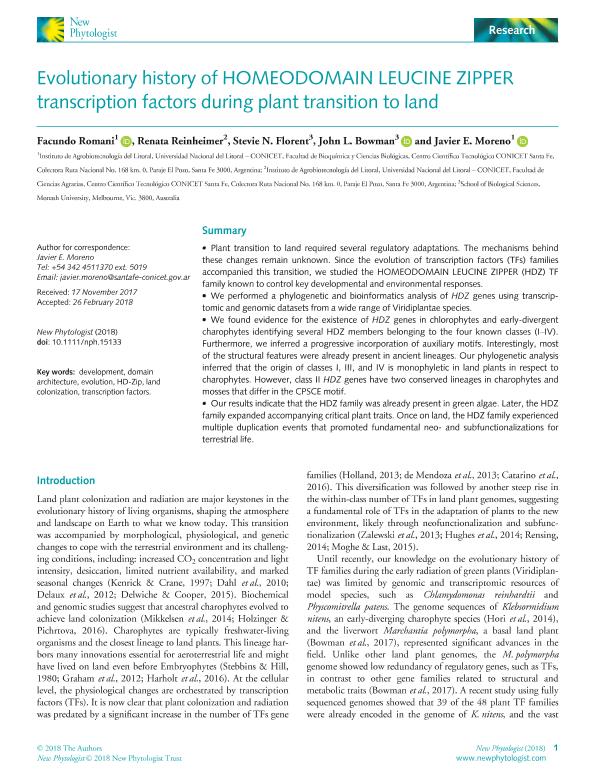Artículo
Evolutionary history of HOMEODOMAIN LEUCINE ZIPPER transcription factors during plant transition to land
Romani, Facundo Alihuen ; Reinheimer, Renata
; Reinheimer, Renata ; Florent, Stevie N.; Bowman, John L.; Moreno, Javier Edgardo
; Florent, Stevie N.; Bowman, John L.; Moreno, Javier Edgardo
 ; Reinheimer, Renata
; Reinheimer, Renata ; Florent, Stevie N.; Bowman, John L.; Moreno, Javier Edgardo
; Florent, Stevie N.; Bowman, John L.; Moreno, Javier Edgardo
Fecha de publicación:
07/2018
Editorial:
Wiley Blackwell Publishing, Inc
Revista:
New Phytologist
ISSN:
0028-646X
Idioma:
Inglés
Tipo de recurso:
Artículo publicado
Clasificación temática:
Resumen
Plant transition to land required several regulatory adaptations. The mechanisms behind these changes remain unknown. Since the evolution of transcription factors (TFs) families accompanied this transition, we studied the HOMEODOMAIN LEUCINE ZIPPER (HDZ) TF family known to control key developmental and environmental responses. We performed a phylogenetic and bioinformatics analysis of HDZ genes using transcriptomic and genomic datasets from a wide range of Viridiplantae species. We found evidence for the existence of HDZ genes in chlorophytes and early-divergent charophytes identifying several HDZ members belonging to the four known classes (I–IV). Furthermore, we inferred a progressive incorporation of auxiliary motifs. Interestingly, most of the structural features were already present in ancient lineages. Our phylogenetic analysis inferred that the origin of classes I, III, and IV is monophyletic in land plants in respect to charophytes. However, class IIHDZ genes have two conserved lineages in charophytes and mosses that differ in the CPSCE motif. Our results indicate that the HDZ family was already present in green algae. Later, the HDZ family expanded accompanying critical plant traits. Once on land, the HDZ family experienced multiple duplication events that promoted fundamental neo- and subfunctionalizations for terrestrial life.
Archivos asociados
Licencia
Identificadores
Colecciones
Articulos(IAL)
Articulos de INSTITUTO DE AGROBIOTECNOLOGIA DEL LITORAL
Articulos de INSTITUTO DE AGROBIOTECNOLOGIA DEL LITORAL
Citación
Romani, Facundo Alihuen; Reinheimer, Renata; Florent, Stevie N.; Bowman, John L.; Moreno, Javier Edgardo; Evolutionary history of HOMEODOMAIN LEUCINE ZIPPER transcription factors during plant transition to land; Wiley Blackwell Publishing, Inc; New Phytologist; 219; 1; 7-2018; 408-421
Compartir
Altmétricas



